
POWER TOOL SAFETY - cont'd
Dust generated from certain materials can be
hazardous to your health. Always operate saw in
welt-ventilated area and provide for proper dust
removal.
SPECIFIC SAFETY INSTRUCTIONS FOR
THiS MITER SAW
1. USE ONLY CROSS-CUTTING SAW BLADES.
When using carbide tipped blades, make sure they
have a negative hook angle. Do not use blades with
deep gullets as they can deflect and contact guard.
2. DO NOT operate the miter saw until it is completely
assembled and installed according to these
instructions.
3. IF YOU ARE NOT thoroughly familiar with the
operation of miter saws, seek guidance from a
supervisor, instructor, or other qualified person.
4.
.
.
ALWAYS hold the work firmly against the fence and
table. DO NOT perform any operation free hand.
KEEP HANDS out of the path of the saw blade. If
the workpiece you are cutting would cause your
hands to be within 621/2 '' inches of the saw blade,
the workpiece should be clamped in place before
making the cut.
BE SURE the blade is sharp, runs freely, and is free
of vibration.
7. ALLOW the motor to come up to fun speed before
starting cut.
8. KEEP THE MOTOR AIR SLOTS CLEAN and free
of chips or dust.
9, ALWAYS MAKE SURE all handles are tight before
cutting, even if the table is positioned in one of the
positive stops.
10.BE SURE blade and collar are clean and that the
arbor screw is tightened securely.
!1.USE only blade collars specified for your saw.
12. NEVER use blades larger or smaller in diameter
than 10 inches.
13.
I4.
NEVER apply lubricants to the blade when it is
running.
ALWAYS check the blade for cracks or damage
before operation. Replace a cracked or damaged
blade immediately_
!5. NEVER use blades recommended for operation at
less than 4800 RPM
!6. USE the blade guards at all times.
17,ALWAYS keep the blade guards in place.
18.NEVER reach around the saw blade.
19.MAKE SURE the blade is not contacting the
workpiece before the switch is turned ON.
20,NEVER unplug the saw with the switch in the ON
position.
21.IMPORTANT: After completing the cut, release the
power switch and wait for the blade to stop before
returning the saw to the raised position.
22.1VlAKE SURE the blade has come to a complete
stop before removing or securing the workpiece,
changing the workpiece angle, or changing the
angle of the blade.
23.NEVER cut ferrous metals or masonry with this tool.
24,NEVER cut smatl pieces.
25.PROVIDE adequate support to the sides of the saw
table for Iong work pieces.
26.NEVER use the miter saw in an area with flammable
liquids or gases.
27.NEVER use solvents to clean plastic parts. Solvents
could possibly dissolve or otherwise damage the
material.
28,SHUT OFF the power before servicing or adjusting
the too!.
29.DISCONNECT the saw from the power source and
clean the machine before leaving it,
30.MAKE SURE the work area is clean before leaving
the machine.
31. SHOULD any part of your miter saw be missing,
damaged, or fail in any way, or any electrical
component fail to perform properly, shut OFF the
switch and remove the plug from the power supply
outlet. Reptace missing, damaged, or faiIed parts
before resuming operation.
ELECTRICAL REQUIREMENTS
POWER SUPPLY AND MOTOR
SPECIFICATIONS
The AC motor used in this saw is a
nonreversible type. See MOTOR in the
SPECIFICATIONS section on page 2.
universal,
PRODUCT
To avoid electrical hazards, fire hazards, or damage to
the tool, use proper circuit protection. Your saw is wired
at the factory for 120V operation. Connect to a I20V, !5
Amp circuit and use a 15 amp. time delay fuse or circuit
breaker. To avoid shock or fire, if power cord is worn or
cut, or damaged in any way, have it replaced
immediately.
DOUBLE INSULATED []
The power tool is double insulated to provide a double
thickness of insulation between you and the tool's
electrical system, All exposed metal parts are isolated
from the internal metal motor components with protecting
insulation.
Replacement parts - When servicing use only identical
replacement parts.
Polarized plugs - This saw has a plug that looks iike
the one shown below:
il 'L2_2_i!r
I,q-h /
To reduce the risk of electrical shock, this saw has a
polarized plug (one blade is wider than the other). This
plug will fit in a polarized outlet only one way. If the plug
does not fit fully in the outlet, reverse the plug. If it still
does not fit, contact a qualified electrician to install the
proper outlet. Do not change the plug in any way.
Double insulation does not take the place of normal
safety precautions when operating this tool.
To avoid electrocution:
1. Use only identical replacement parts when servicing
a tool with double insulation. Servicing should be
performed by a qualified technician.
2. Do not use power tools in wet or damp locations or
expose them to rain or snow. This tool is intended for
indoor use only_
MOTOR SAFETY PROTECTION
IMPORTANT."
To avoid motor damage, the motor shoutd be blown out
or vacuumed frequently to keep sawdust from interfering
with the motor ventilation.
1.Connect this saw to a 120V, 15 amp. circuit with a 15
amp. time delay fuse or circuit breaker. Using the
wrong size fuse can damage the motor.
2. If the motor won't start, release the trigger switch
immediately. Unplug the saw. Check the saw blade to
make sure it turns freely. If the blade is free, try. to start
the saw again. If the motor still does not start, refer to
the TROUBLESHOOTING GUIDE.
3. If the tool suddenly stalls while cutting wood, release
the trigger switch, unplug the tool, and free the blade
from the wood. The saw may now be started and the
cut finished.
4. FUSES may "blow" or circuit breakers may trip
frequently if:
a. MOTOR is overloaded - overloading can occur if
you feed too rapidly or make too many start/stops
in a short time.
b. LINE VOLTAGE is more than 10% above or below
the nameplate voltage rating. For heavy !oads,
however, the voltage at motor terminals must equal
the voltage specified on the nameplate.
c. IMPROPER or dull saw blades are used.
5. Most motor troubles may be traced to loose or
incorrect connections, overload, tow voltage or
inadequate power supply wiring. Always check the
connections, the load and supply circuit if the motor
doesn't run well. Check minimum gauge for the length
of cord you are"using on the chart below.
GUIDELINES FOR EXTENSION CORDS
Use proper extension cord. Make sure your extensiorh
cord is in good condition. When using an extension cord,
be sure to use one heavy enough to carry the current
your product will draw. An undersized cord will cause a
drop in line voltage, resulting in loss of power and cause
overheating. The table below shows the correct size to
use depending on cord length and nameplate ampere
rating. If in doubL use the next heavier gauge. The
smaller the gauge number, the heavier the cord.
Be sure your extension cord is properly wired and in
good condition. Atways replace a damaged extension
cord or have it repaired by a qualified person before
using it. Protect your extension cords from sharp objects,
excessive heat and damp or wet areas.
Use a separate electrical circuit for your tools, This
circuit must not be less than # 12 wire and should be
protected with a 15 Amp time delay fuse. Before
connecting the tool to the power line, make sure the
switch is in the OFF position and the electric current is
rated the same as the current stamped on the motor
nameplate, running at a lower voltage will damage the
motor.
i
(When using 120 volts onty)
Ampere Rating Total length of cord in feet
more than not more than / 25' 50' 100' 150'
0 6 ] 18' 16' 16' t4' "_
6 10 _: t6' 14' 12'
10 12 J 16' - 16' 14' 12'
t
t2 16 I !4' 12' not recommended
CAUTION: in all cases make certain the receptacle in
question is properly grounded. If you are not sure have a
certified electrician, check the receptacle.

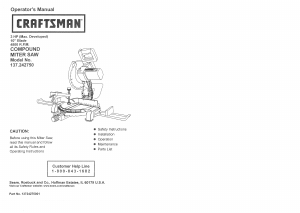


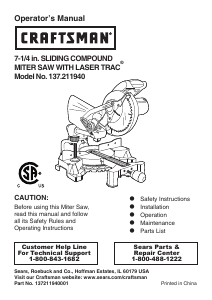
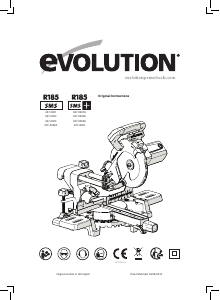
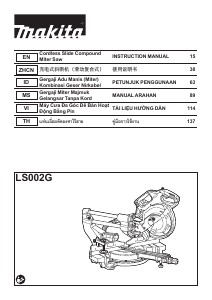
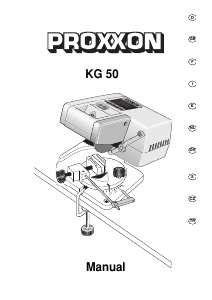

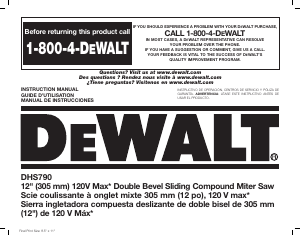
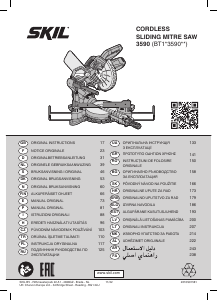
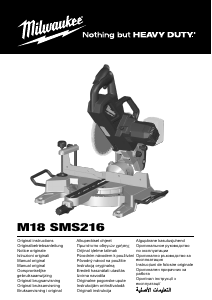
Join the conversation about this product
Here you can share what you think about the Craftsman 137.242750 Mitre Saw. If you have a question, first carefully read the manual. Requesting a manual can be done by using our contact form.